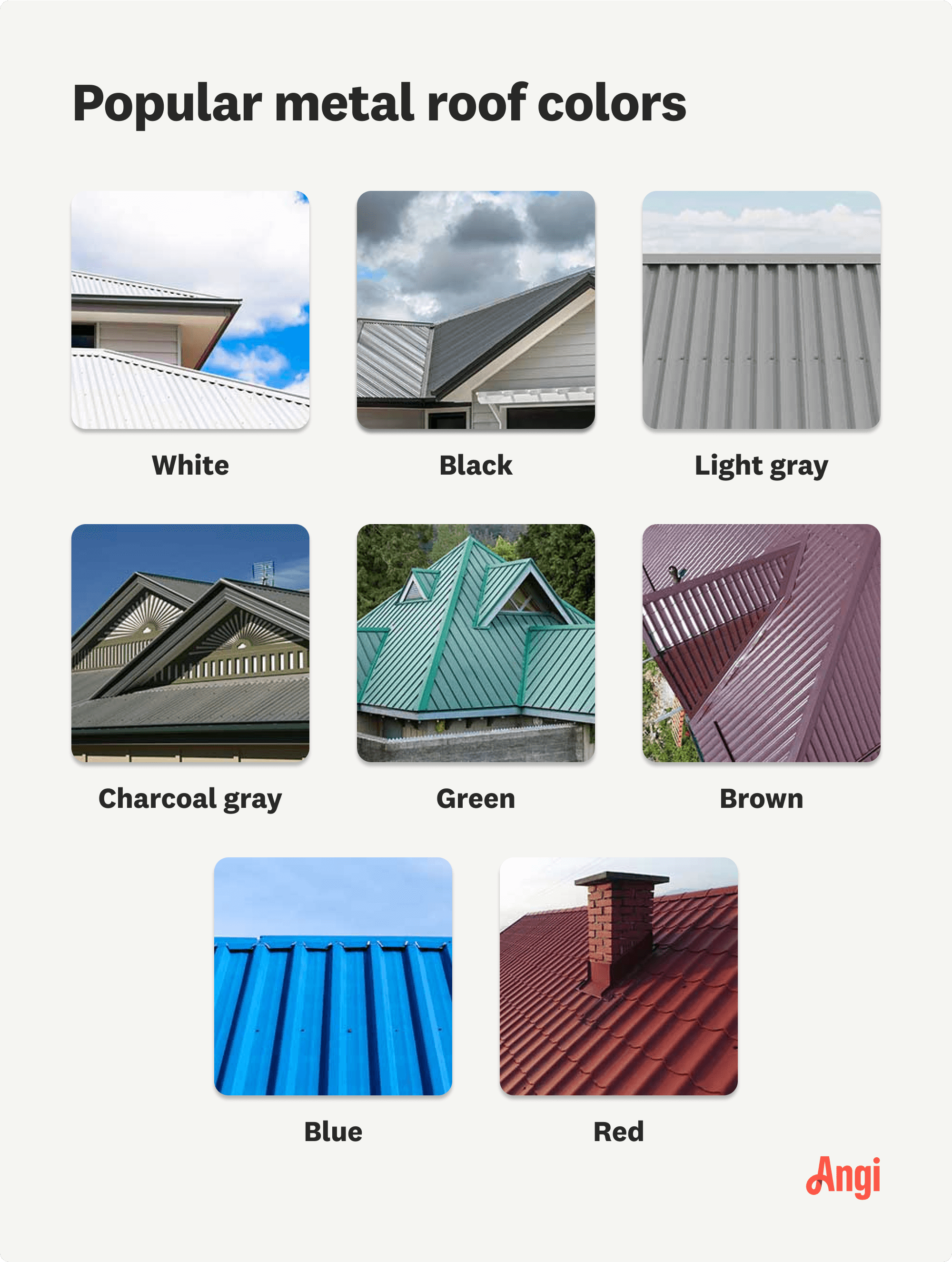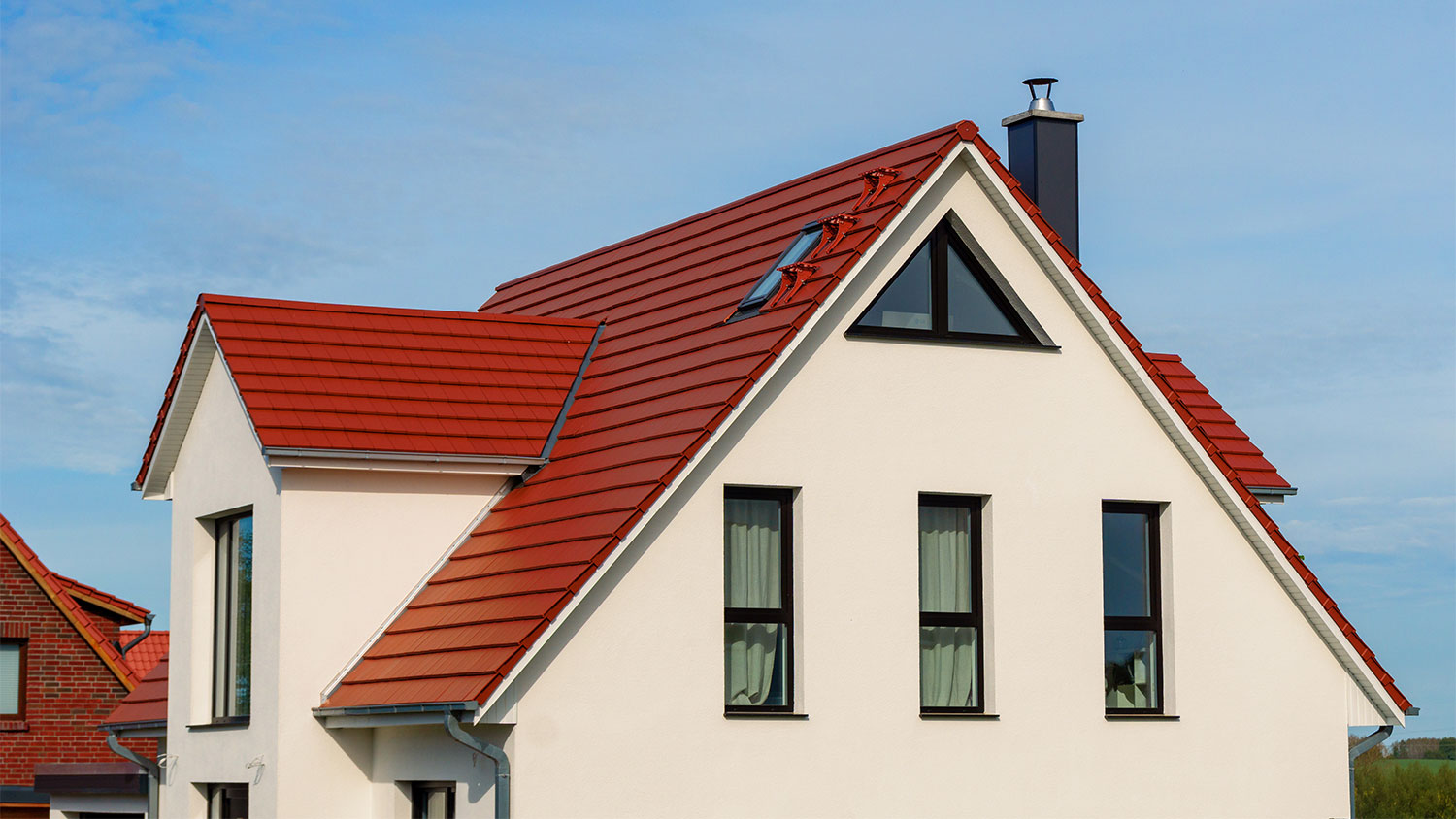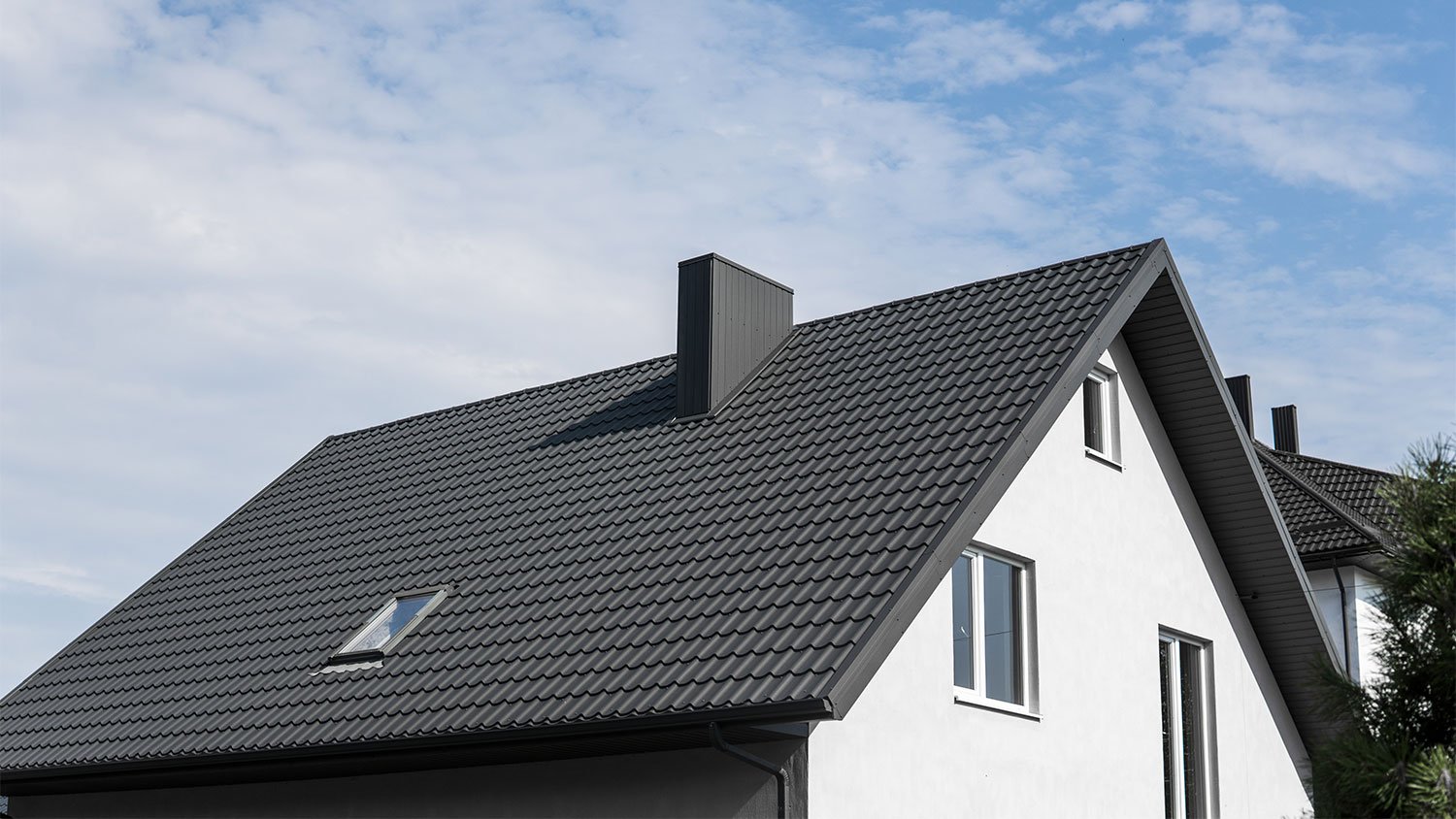
The cost to install wood soffit depends on your roof’s size and the location of the soffit. Learn why it isn’t just the expensive materials that impact cost.
Your home’s style, location, and features will help determine the best metal roofing color


As metal roofing becomes increasingly popular, more and more homeowners are struggling with how to choose a metal roof color. You can find success with just about any shade of the rainbow. Of course, having so many options makes it tricky to settle on just one. But there are a few factors—like the weather, where you live, and the style you are trying to achieve—that will help you determine what is right for you.
While factory finishes are the most common way to get color on a roof, you can paint an existing metal roof for cosmetic reasons, to change colors, to refresh an aging roof, and to make metal roofs even more reflective and energy efficient. Whether you need a color to match your clay-toned stucco siding or one that will help you cut down on energy costs, this guide can help you find the best one for your metal roof.
If you live in a neighborhood with a homeowners’ association, find out what roof colors it allows before considering your options. HOA boards can take weeks to months to respond to requests, so be sure to plan the project well in advance. Take a look at your community’s handbook or website to find out what they generally do and do not approve so you can get a head start. Even then, some preapproved colors may not be allowed for any number of reasons, such as your neighbor having the same roof color or a change in the regulations.
Even if you do not have an HOA, neighborhood factors can help you make a smart roof color choice. If you live in a traditional neighborhood with neutral-colored homes and roofs, putting a bright color like red or blue on your home may make it stand out in a not-so-good way. You do not have to toe the line and deny your own preferences for the sake of your neighbors, but it can be worth thinking about whether your roof color choice will draw unwanted attention. You may not like your property being known as “the house with the orange roof.”
This is especially important if you intend to sell your home at some point. While it is possible for buyers to repaint or replace the roof, you can inadvertently hurt your home’s selling price or chase away potential buyers if you have selected a roof color that is too wild or bright for average tastes or the neighborhood’s feel. Metal roofs are often a draw for buyers who like the idea of long-lasting and low-maintenance roofing, so you do not want the color to make them think twice.
A good place to start when choosing a metal roof color is to consider your home’s shape and style. The shape, height, and size of your roof will be a big factor in how much paint is visible; if the roof is large or complicated, bright or bold colors can take over and distract from your home. Different types of metal roofs may also look better in certain colors; for example, bold or dark colors like red or dark gray look great on a standing seam roof.
Architectural styles matter, too. If your home has a modern construction style, consider dark, matte roofing; farmhouse-style buildings tend to look best with red, white, and gray roofs that play up their barn-like or rural influences. Spanish and Mediterranean styles often feature roofs that are red, brown, dark orange, or rust tones, mimicking traditional clay tile roofs. Traditional homes may benefit from deep browns, dark greens, and wood-toned roofing.
While the roof might be your home’s largest span of uninterrupted color, you should consider the color of your home itself and other visible features when choosing the hue of your roof. Unless you also plan to change those colors for a whole-house update, you will want your new roof to complement the existing colors on and around your home. In some cases, painting your roof to match your home can save you expensive roof replacement costs, while giving it a whole new look for much less money.
Fascia, trim, gutters, downspouts, and other features add visual interest to a home. When you coordinate these items with the color of your roof, you can give your house a cohesive, pleasing look. For many homeowners, this could be a dark roof with lighter trim, or light trim balanced by a dark roof. For those with bolder tastes, the roof could add a pop of color that caps off a home with monotone or coordinating features.
Color can make your roof look different, too. For example, lighter-colored roofs can appear taller. If your home has a low-slope roof or a shallow pitch and you wish it looked taller, painting it a lighter color can give the impression of a taller structure. In contrast, darker colors make roofs look smaller, less sloped, or less tall. This is your chance to improve the balance and look of your roof, so use it wisely and choose the right color to make your home look its best.

If you are not particularly interested in a theme but still want to find a unique color for your metal roof, look to the world around you. Matching a roof color to the natural elements in your area will help your house to meld into the surrounding environment and give you a cozy place in nature—or in the neighborhood—to call home. Dark greens and woody browns are excellent for homes in forest or mountain regions, whereas light grays and tans feel right at home in desert landscapes.


A candy pink roof might be the perfect pop of color during a mellow sunset, but it can be overwhelming when the sun is blazing at high noon. In general, it is better to find out if your chosen roof color will look good around the clock to avoid any surprises. If you cannot visualize it on your own, paint a small part of your roof to put it to the test. That way, if it ends up being a dud, you will not have much to paint over.
When choosing a color, keep in mind that the finish matters, too. Colors often come in glossy and matte versions, so think about whether you prefer the sun to reflect off the paint during the middle of the day when it is high in the sky or if a matte finish will look too dull or flat for your tastes during evening and morning hours.
Another factor to consider is whether the roof is in a position to reflect off and change the appearance of the main house color. For example, if your roof has deep valleys that are lower than some of the siding, or if you extend the roof color to lower porch roofs, the sun can cause the roof to reflect off the main house. If your home is white and your roof is red, that can make areas of your home’s paint appear pink.
Weather affects the color of your roof just as much as the time of day. Think about how bright and welcoming a beaming yellow roof would be on a drizzly gray day. On the flipside, neutral earth tones might be better suited to a seaside home surrounded by coastline colors. The sun’s reflecting rays can make colors look more vibrant, so bright or bold colors will appear even brighter; on the other hand, metal roofs in cloudier or gloomier areas can appear darker than they actually are.
Another factor to consider is that, over time, weather can fade metal roofing colors. Harsh UV rays, salty coastal air, pollution chemicals, and moisture all contribute to breaking down pigments in the paint and dulling shiny finishes. Because UV rays cause the most fading, roofs that do not get even sun exposure can fade unevenly, with more exposed areas becoming lighter faster than shaded areas. When choosing a metal roof color, select a high-quality paint that resists fading, and keep in mind that lighter, less vibrant, and matte roofs will fade less than darker, brighter, and glossier paint colors.

The color you choose can impact the energy efficiency of your home. Light colors are a favorite of desert dwellers and people who live in hotter climates because they better reflect the sun’s heat and protect homes from extreme heat. Darker colors are common in colder climates because they do the opposite—trap heat and use it to warm the house. The finish matters, too; high-gloss roofs will reflect the sun’s rays much more than matte roofing will.
Cool metal roofs are a smart option for homes with hot summers and heat year-round and for homeowners who want to increase efficiency and save money on cooling bills. Cool roofing is specially painted or coated to reflect the sun’s rays and prevent it from heating up the roof and attic, which can make the whole home hotter. When done correctly, cool roofs can lower cooling bills and energy costs up to 15%. While metal is naturally more reflective than other types of roofing, including asphalt shingles, cool metal roofing benefits from the paint or coating that makes it even more reflective.
If you choose a cool roof, you will be doing more than just saving money on your energy bills and protecting your HVAC system from working too hard. En masse, cool roofs can help to combat the heat island effect, which makes cities warmer. They also lower overall power plant emissions and help protect local power grids from being overtaxed during hot weather.
If your existing metal roof needs a facelift, metal roof paints can give it a whole new look. You can choose among hundreds of colors and several finishes for a customized result that fits your home and your needs.
The most important thing, along with color choice, is to choose a high-quality paint that is specially formulated for use on metal roofing. Roof paint has to bear the brunt of harsh elements and near-constant UV rays for years without fading, chalking, peeling, or etching. You may also want to go a step further and opt for a specialty coating or sealant that will serve as an extra layer of protection and help the paint to last even longer. Since the cost to paint a roof is not cheap, make sure you invest in quality products to get the most value and longest-lasting roof paint for your money.
There are two basic types of paint systems you can choose from for your roof: silicone modified polyester paint (SMP) and polyvinylidene fluoride (PVDF). Experts consider SMP to be a good product, and its superior hardness prevents it from scratching. It is also much more affordable than other options.
PVDF, often referred to by product names such as Kynar 500® or Hylar 5000®, is the highest-quality paint you can find to stand up against temperatures, UV rays, oxidization, humidity, moisture, and pollution. This means that the colors stay truer to their original hues for longer, lasting for decades. Because of this, PVDF paints are more expensive than lower-quality paints.
Hiring a pro to paint a metal roof costs anywhere from $1,150 to $3,630, depending on the size of your roof. Doing it yourself can be less expensive, since you will only be paying for materials, like paint. Still, a project like this can be dangerous, hard for novices to do right, and is generally not recommended for non-professionals. So, it may be best to call in an expert to ensure the job is done safely, to get the best outcome, and to have warranty protection.
If you do not yet have a metal roof but are considering one, you can choose a paint color and have it factory-applied to your new roofing before installation. Or, if you are in the market for a more naturally colored roof, consider metals that have or develop their own distinct colors or patinas, such as galvanized aluminum, copper, and zinc. This is a great way to get the look you want right from the start without having to paint or coat your metal roof once it has been installed.
New metal roofs are an investment, but they can be well worth it, especially when you consider most will last 50 years or longer and are extremely durable. The average metal roof cost is $5,600 to $16,400 for a typical 2,200-square-foot house; however, the type of metal, type of fastener system, shape of the roof, cool roof coatings, and other factors can greatly affect this cost.
From average costs to expert advice, get all the answers you need to get your job done.

The cost to install wood soffit depends on your roof’s size and the location of the soffit. Learn why it isn’t just the expensive materials that impact cost.

Getting a wind mitigation inspection can work in your financial favor. Learn about the average wind mitigation inspection cost, including ways to save.

Rubber roof costs vary considerably for each project. Learn how factors other than roof size and labor contribute to the total cost.

Are you trying to pick a soffit and fascia material for your roof? Here are 10 options for the right finishing touch on your house.

Your home's new tin roof cost will depend on several factors, including its size, materials, style chosen, complexity, and added options.

Dormer additions are both stylish and practical. Check out how to increase your attic's living space while boosting your home's curb appeal.